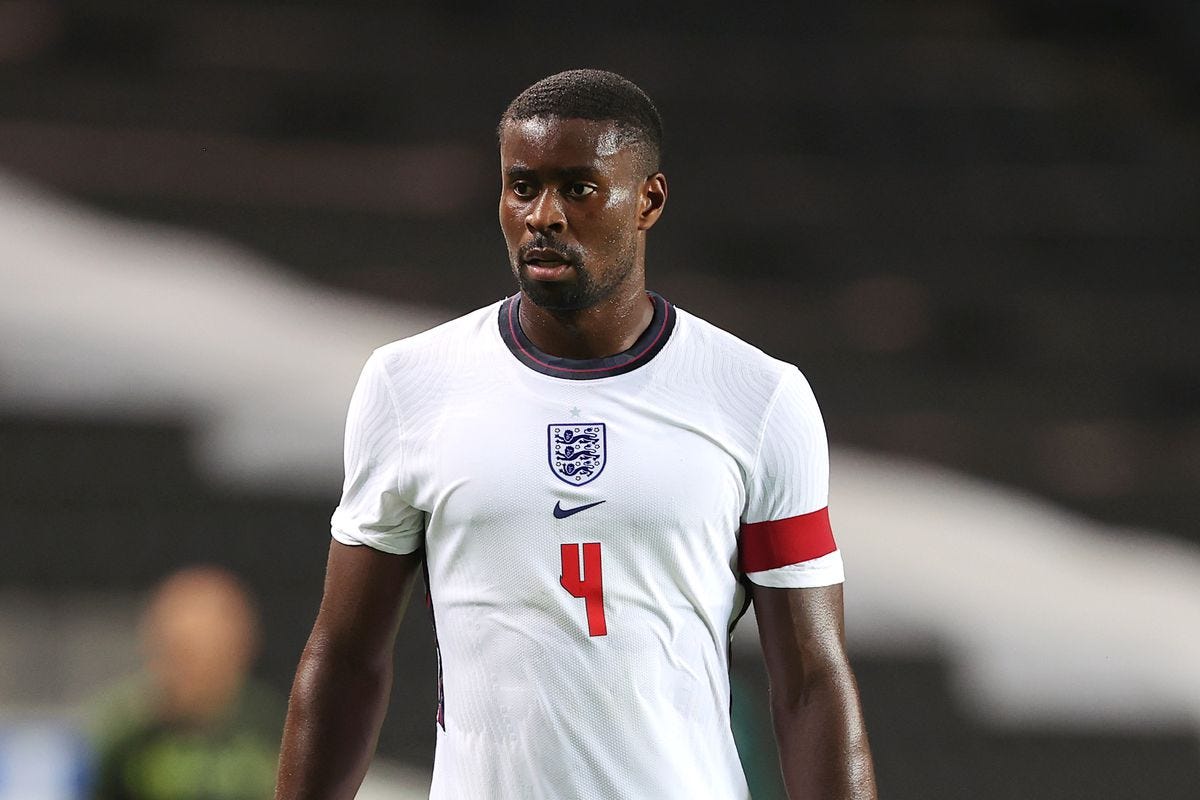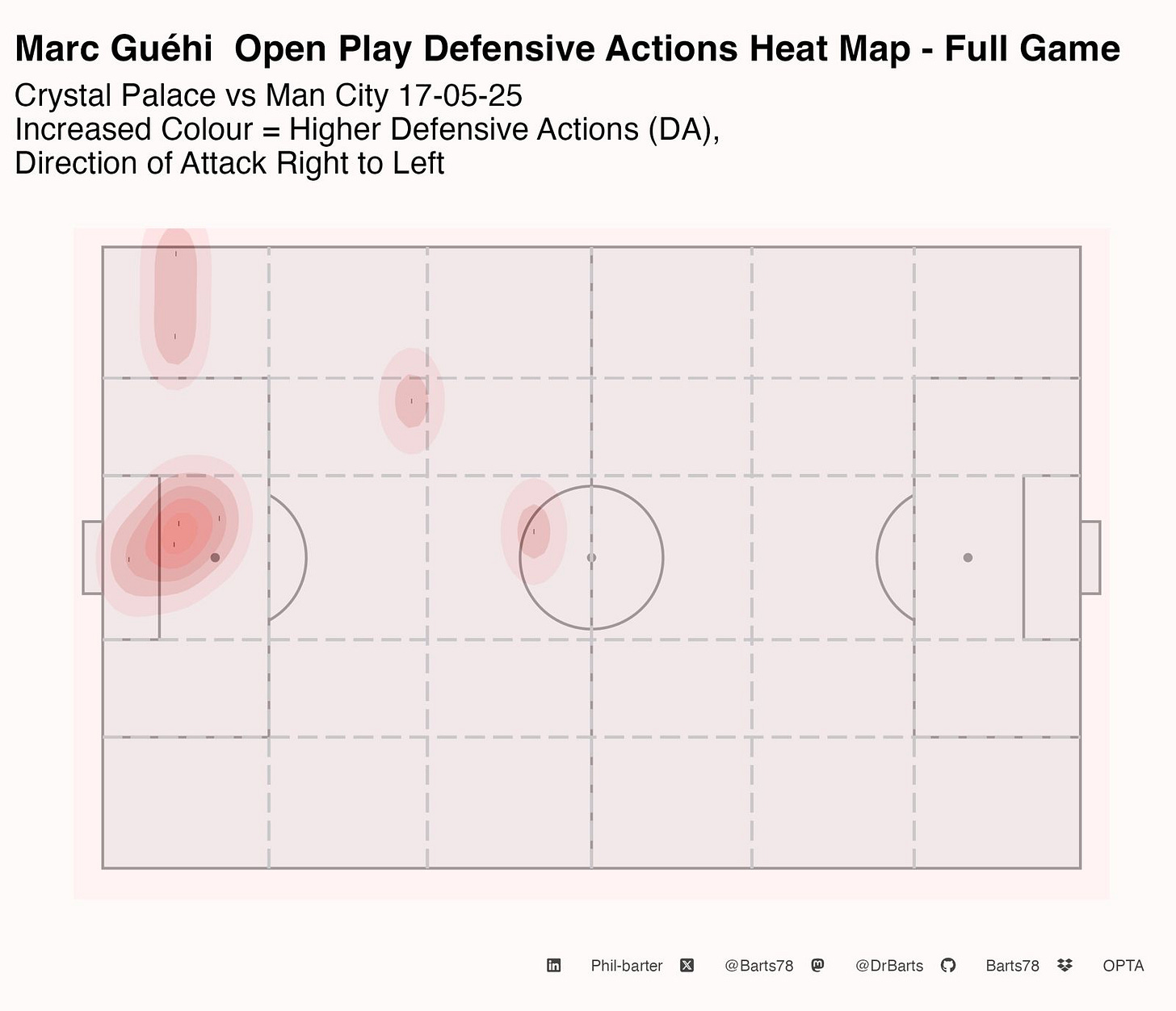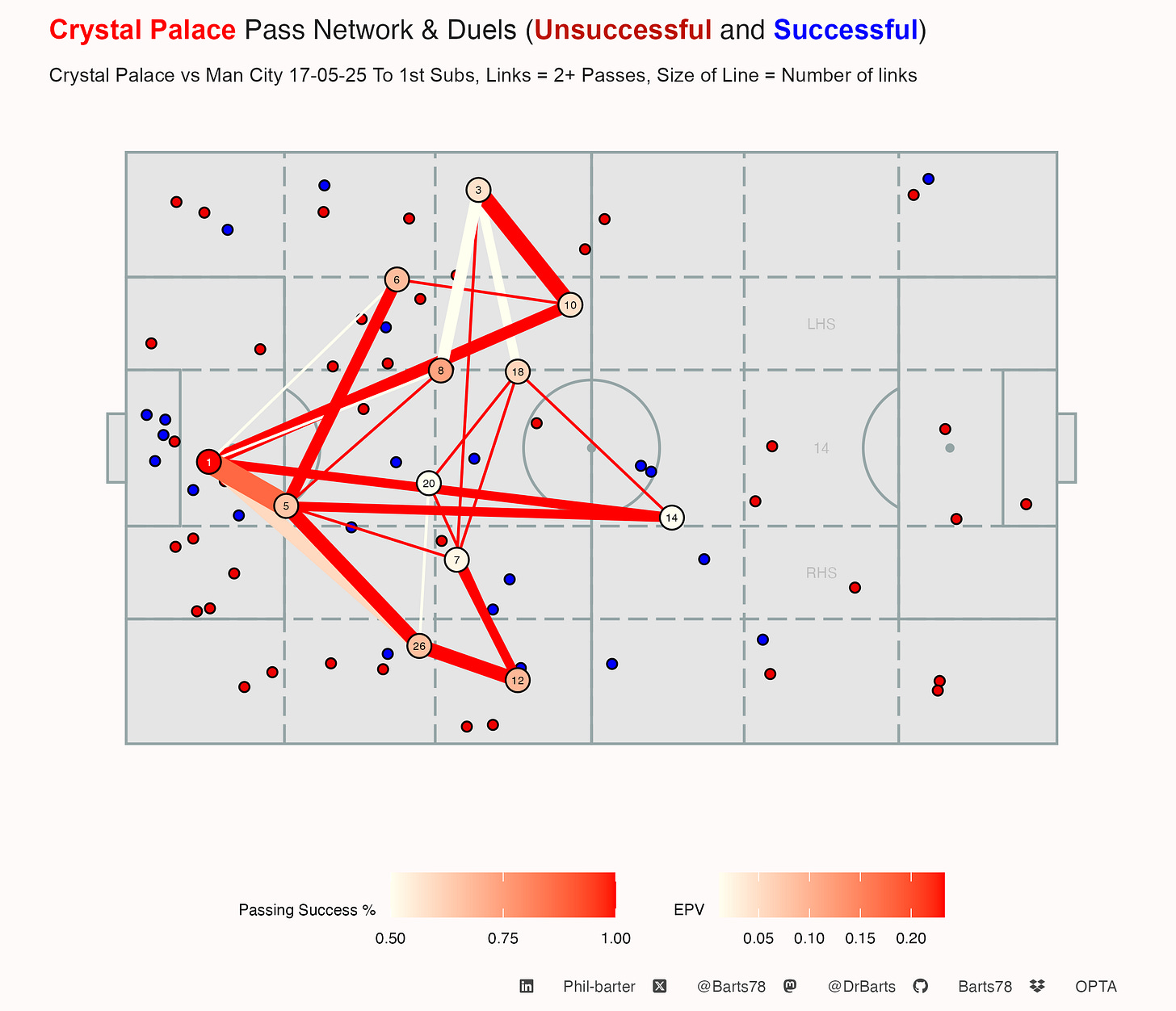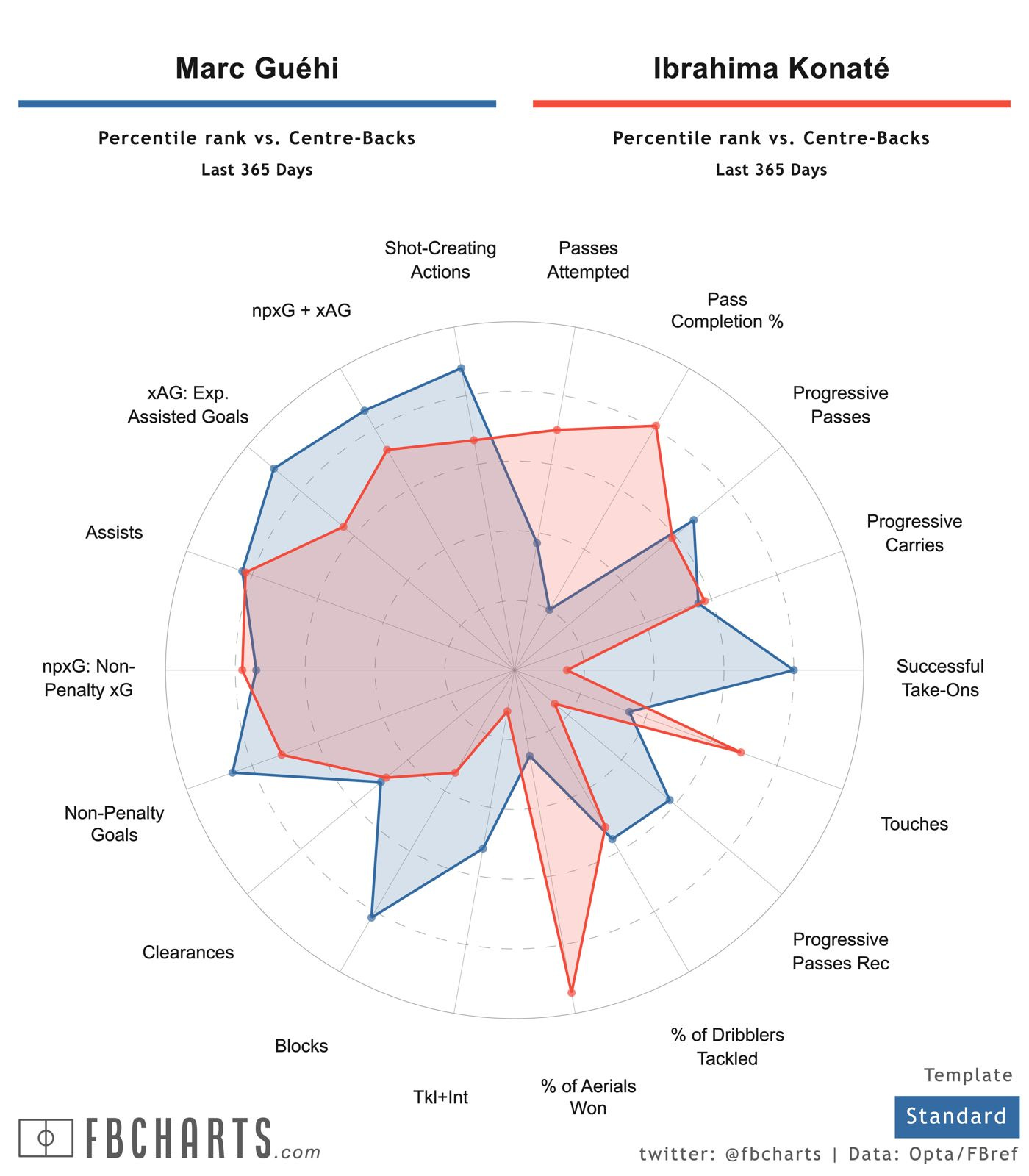Marc Guéhi to Liverpool: Aerial Concerns vs On-Ball Strengths
Analysing Marc Guéhi’s Fit in Arne Slot’s Liverpool Defence
After Liverpool’s title-winning campaign under Arne Slot, one thing remains clear, centre-back depth is still a live issue. With Jarell Quansah leaving, there is room for another body in that backline. One name that has returned to the rumour mill with a bang Marc Guéhi, and the more I look at him, the more I think he might just be the smart play.
Premier League experience matters
Let me start with the dull but necessary bit. Marc Guéhi’s aerial win rate is 54%, and has hovered around that number for several seasons. That’s not elite and yes, if you’re taking height out of the team, with players like Frimpong and Kerkez coming in, then you need to be careful. But what Guéhi does have is experience. Not just minutes in the Premier League, but regular, consistent, top-level football.
He has captained Palace. He’s an England international. He’s played on the left and right of a back four, occasionally filled in at full-back and even stepped into midfield at times. As the above image shows in a recent game, his defensive actions are mainly deep and in the left CB area. The way Palace setup will dictate this to a degree. However the position flexibility does not just help the squad, it helps the manager solve problems mid-season without compromising structure.
Some say he’s below Konaté and Van Dijk in terms of quality, which is probably fair. But not every signing is about being better than your best players. Sometimes it’s about ensuring there is no drop-off when others rotate.
On-ball ability and passing profile
What surprised me when I went through the numbers was how much on-ball threat Guéhi provides. His through balls rank in the 98th percentile. His switches of play are in the 75th percentile. He is capable of hitting that big diagonal from left to right, and as Liverpool fans know, that’s a key part of how we break low blocks, think of Van Dijk’s passes to Salah.
as the above pass network indicates, you don’t see as much is the short and medium-range connection play from Guéhi (number 6 in the image). His pass completion in those zones is around the 30th and 40th percentiles. as you can see from this game, he mainly played the pass to the left 8 zone or back to his CB colleague. That might partly be down to the system at Palace. When I looked at Adam Wharton’s numbers, there was a similar drop, which suggests it could be tactical rather than technical. At a team like Liverpool, where short and medium passing is more structured and options more frequent, those numbers might naturally improve.
Still, it’s fair to say he prefers longer passes and that shows in the data, 71st percentile for long passes attempted 8.06 per 90. Guéhi was 13th in the Premier League last season for long passes, just two places behind Van Dijk. That suggests a player who understands how to bypass pressure and move the ball upfield quickly. The below threat (EPV) heat map shows he is involved from deep, starting those moves using his long passes. His threat number for the season per 90 is 0.11, which is slightly above Konate’s figure of 0.10, VVD finished with 0.13 . Incidentally another previous target Huijsen finished the season with a per 90 threat of 0.12, so this might also be a factor in the Liverpool scouting guys targeting Guéhi.
Physical and defensive profile
Guéhi does not dominate in the air, but what he does do is defend with consistency. He’s second percentile for dribblers tackled, which is very strong. His block rate is in the 96th percentile, meaning he gets in the way of shots and crosses more than most. Interceptions and challenges lost are less impressive, but again, this reflects the type of defending Palace do, a lot of it is reactive.
When you put him up against Ibrahima Konaté, what you see is not a direct comparison but a different skillset. Guéhi offers more in progressive passes, take-ons, and blocks, while Konaté dominates aerially and in physical duels. If Van Dijk and Konaté are your starters, Guéhi brings a complementary set of tools, not a duplicate.
Concerns in the air: Aerial numbers in context
It would be disingenuous not to address the biggest question around Marc Guéhi, his aerial numbers.
Last season, he was involved in 3.71 aerial duels per 90 minutes, winning just 54% of them. That figure has remained consistent for multiple seasons. For comparison, Ibrahima Konaté had a 72% success rate in a similar number of duels, and Virgil van Dijk came in at 72% as well, with a slightly higher duel volume. You would notice the difference if you swapped Guéhi in for either of them.
I’ve talked before about the importance of aerial dominance, especially under Klopp. Whether Arne Slot and the current recruitment team see it the same way is another matter. Judging by recent targets, like Dean Huijsen and Tomás Araújo, there seems to be a greater emphasis on what players can do with the ball than what they win in the air.
Still, you have to acknowledge that Liverpool would be physically smaller if Guéhi replaced Konaté. Combine that with other signings like Frimpong and Wirtz, and it becomes a trend. That isn’t a criticism, but it is a reality, and it makes the structure of the back four even more important.
The aerial concern doesn’t mean Guéhi cannot defend. It just means you have to build differently around him. Slot may view Guéhi as someone who can eventually take Van Dijk’s place, not Konaté’s. That would explain the logic, both are right-footed, left-sided centre-halves who like long switches and lead their teams from the back.
Price point and the logic of the move
This is where it becomes more obvious why Guéhi could be Liverpool’s pick. Reports suggest he could be available for around £45 million. For a Premier League centre-back, an England international, and a captain with over 100 top-flight appearances, that’s a fair deal.
Compare that with someone like Castello Lukeba, who looks good on paper but is said to be valued at £60–70 million or Jorrel Hato, who has played mainly left-back and doesn’t yet profile clearly as a Premier League-ready centre-half. Guéhi sits in the middle. He is not perfect, but he is proven, fit, and ready to play now.
One thing that struck me with the player profile and the data was this: while others like Lukeba may have better aerials or carrying stats, Guéhi brings Premier League certainty, and that matters in this position. When you play centre-half at Liverpool, you’re exposed. There’s no hiding. Having someone who already knows the physicality and rhythm of the league is a significant plus.
Final thoughts
We do not know exactly what Arne Slot wants from his centre-halves yet. But if we look at previous targets like Dean Huijsen, and at Guéhi’s long pass and progressive numbers, it’s not a stretch to think he fits the model. He adds depth, raises the floor, and offers reliability.
For £45 million, you’d be getting someone who can play 30 games a season without a drop in standard, who understands the league, who leads a dressing room, and who adds tactical flexibility. That is not a marquee signing, but it might be a winning one.
And frankly, with Liverpool going into a season defending the Premier League title, that’s exactly what we need.






